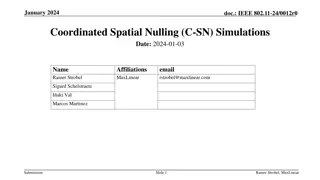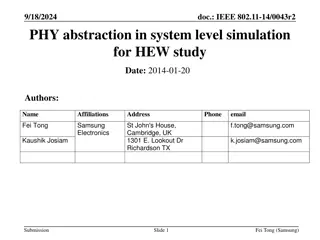Automotive Considerations for IEEE 11-14/0586r0 Simulation Scenarios
This document discusses the integration of automotive-related scenarios into IEEE 802.11ax simulation scenarios, focusing on the use of high-speed WLAN in vehicles, particularly during traffic jams. The characteristics, requirements, and challenges of establishing a data link in traffic congestion scenarios are outlined, highlighting the need for efficient in-cabin WLAN deployment despite unmanaged environments and changing interference conditions. Practical considerations for implementing WLAN in vehicles are presented, emphasizing the evolving role of wireless LAN in the automotive industry.
Download Presentation

Please find below an Image/Link to download the presentation.
The content on the website is provided AS IS for your information and personal use only. It may not be sold, licensed, or shared on other websites without obtaining consent from the author.If you encounter any issues during the download, it is possible that the publisher has removed the file from their server.
You are allowed to download the files provided on this website for personal or commercial use, subject to the condition that they are used lawfully. All files are the property of their respective owners.
The content on the website is provided AS IS for your information and personal use only. It may not be sold, licensed, or shared on other websites without obtaining consent from the author.
E N D
Presentation Transcript
May 2014 doc.: IEEE 11-14/0586r0 Automotive Considerations for the Simulation Scenarios Date: 12-May-2014 Authors: Name Igal Kotzer Affiliations Address General Motors Phone email igal.kotzer@gm.com Submission Slide 1 Igal Kotzer, General Motors
May 2014 doc.: IEEE 11-14/0586r0 Abstract Two automotive related scenarios are presented To allow support of these scenarios in 802.11ax simulation scenarios, an extension to simulation scenario 3 is proposed Submission Slide 2 Igal Kotzer, General Motors
May 2014 doc.: IEEE 11-14/0586r0 Introduction Wireless LAN is becoming an industry de-facto standard in the automotive world The number of vehicle brands and models equipped with WLAN is constantly increasing The leading usage for high speed WLAN in the automotive world is for infotainment Vehicles equipped with high speed WLAN include an in cabin AP Submission Slide 3 Igal Kotzer, General Motors
May 2014 doc.: IEEE 11-14/0586r0 Scenario 1: Traffic Jam Introduction Traffic jams are often encountered during rush hours Idle periods of time while driving in the traffic jam can be used to consume large quantities of data (e.g. video on demand) A high speed data link should be available in this scenario Submission Slide 4 Igal Kotzer, General Motors
May 2014 doc.: IEEE 11-14/0586r0 Scenario 1: Traffic Jam Characteristics Average lane width of a medium to high speed road is 3m-4m The number of lanes ranges between 2 and 6 A typical length of popular full size / mid size vehicles is 3m-4m A typical width of popular full size / mid size vehicles is 1.8m-2.2m A typical distance between two vehicles in a traffic jam is 1m both to the front and to the side Submission Slide 5 Igal Kotzer, General Motors
May 2014 doc.: IEEE 11-14/0586r0 Scenario 1: Traffic Jam Characteristics (2) Vehicle WLAN is unmanaged In the 2.4GHz band only 3 channels are used (1, 6, 11) In cabin WLAN antennas are placed at a position that allows maximum coverage and rate In cabin WLAN transmits at full power (17dBm) Relative speed between adjacent vehicles in a traffic jam is usually low While both the AP and the STA are stationary relative to each other, the OBSS interference is changing over time due to vehicle movement Submission Slide 6 Igal Kotzer, General Motors
May 2014 doc.: IEEE 11-14/0586r0 Scenario 1: Traffic Jam Channel and Distance Illustration 6 1 1 4m 1 11 6m 11 6m 6 6 6 1 1 11 11 11 6 Submission Slide 7 Igal Kotzer, General Motors
May 2014 doc.: IEEE 11-14/0586r0 Scenario 1: Traffic Jam Channel Model Glass penetration loss: 2dB Channel model between vehicles: short distance outdoor (low speed mobile) or indoor Channel model inside the vehicle: indoor (see [2], [3]) Submission Slide 8 Igal Kotzer, General Motors
May 2014 doc.: IEEE 11-14/0586r0 Scenario 2: Driving in a Dense Vehicle Environment Introduction AP and STA are stationary inside the vehicle Vehicle is moving Other vehicles in the surrounding are also moving Energy is radiated from inside the vehicle to neighbouring vehicles and is reflected back to the receiver from the metal surface of the neighbouring vehicles Submission Slide 9 Igal Kotzer, General Motors
May 2014 doc.: IEEE 11-14/0586r0 Proposed Changes to the Simulation Scenario Both of the presented automotive scenarios have similar simulation characteristics Simulation scenario 3 Allow unmanaged operation as well as managed operation Submission Slide 10 Igal Kotzer, General Motors
March 2014 doc.: IEEE 11-14/0586r0 References [1] Simulation Scenarios, IEEE 11-13/1001r9 [2] Intra-Vehicular Channel Model, IEEE 11-14/0088r0 [3] Extended Intra-Vehicle Channel Model, IEEE 11-14/0365 Submission Slide 11 Igal Kotzer, General Motors























